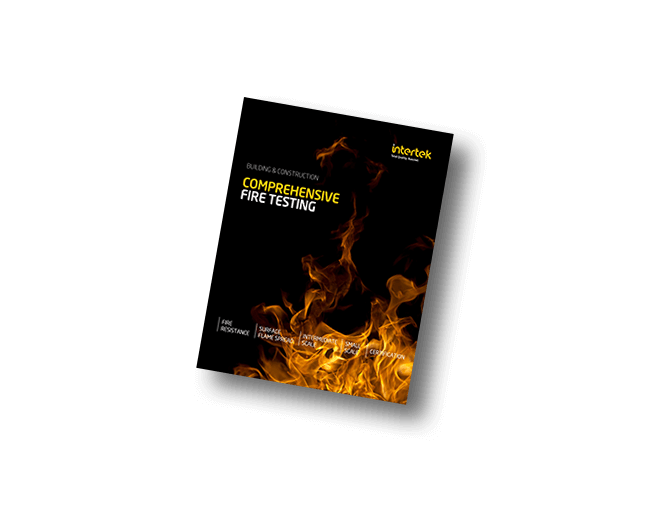Test an entire Fire Department’s Apparatus and Equipment in a single visit
Intertek provides the services required to test a range of fire apparatus including pumps, hoses, ladders, and aerial equipment. This comprehensive onsite service allows clients to quickly meet the requirements of NFPA 1911, N1901, 1932 and 1962 and allows customers to take preventative maintenance designed to keep your fire apparatus operating at its best.
Testing the fire apparatus’ water pump ensures that the pressure to volume efficiency curve and other functions are performing as the manufacturer intended. Annual testing can identify issues with the pump that could cause a failure leading to a catastrophic event for the pump or the emergency it is being used to mitigate.
Testing firefighting hose ensures that operating pressures will not cause a failure that could result in a serious liability to the owner, user, and the emergency that the hose is being used to mitigate.
Testing of ground ladders provides assurance that the ladder has not degraded from use and will withstand a safe load to all components in the event of a rescue or use for access and/or egress during an emergency.
Testing of aerial apparatus, similar to ground ladders, ensures that the equipment can be utilized to its manufactured intended use for rescue and suppression operations.
Intertek offers the industry's most complete suite of fire and flammability testing. Download our comprehensive fire brochure and learn more.
What is Fire Apparatus Testing?
Annual and new-service testing is executed on equipment used for active firefighting use.
Firefighting Equipment Includes:
- Apparatus Water Pumps
- Firefighting Hose
- Fire Department Ground Ladders
- Aerial Apparatus
Why Perform Fire Apparatus Testing?
The primary reason for testing is the safety and assurance that emergency services can utilize equipment without the concern of failure or less than intended efficiency. Intertek’s goal is to test an entire department’s apparatus and equipment in a single visit to return the fire department back to service as quickly as possible.
Testing fire apparatus and equipment can have a direct, positive effect on the ISO rating of a Fire Department’s area of coverage, lowering insurance rates for the community members protected by it. Testing also provides compliance to departments in NFPA jurisdictions that risk funding or closure issues and lessens liability in the case of a catastrophic failure that could have been identified and mitigated by annual testing.
What is the NFPA Standard for Fire Apparatus?
NFPA 1911 is a holistic document for inspection, maintenance, testing, and retirement of in-service emergency vehicles. This differs from NFPA 1901, which prescribes requirements for the manufactured automotive fire apparatus. NFPA 1911 provides guidance on how to ensure in-service fire apparatus are ready at a moment's notice.
How do you test a Fire Truck Pump?
There are two parts of performance testing a vehicle-mounted fire pump: Mechanical testing and Flow testing. Mechanical testing, such as a vacuum test, pressure control device tests, pump interlock testing, primer testing, and engine speed governor testing are evaluated for mechanical effectiveness and performance. Flow tests, such as the capacity test, overload test, GPM at 200 PSI and GPM at 250 PSI, measure specific points of the pumps flow vs. pressure efficiency curve. The pump, during the apparatus manufacturing process is certified to meet a specific flow, as a specific pressure, at a specific engine RPM. The flow tests are executed to evaluate the pumps' performance in the field vs. its manufactured parameters. If any mechanical or flow test results deviate significantly from either NFPA 1911 or original certification requirements, pump maintenance should be performed, and the pump retested.
What does Apparatus mean in Firefighting?
The term “apparatus” refers to the commonly named “fire truck” and is used interchangeably. Apparatus is simply the proper designation for the overall emergency vehicle.
What are the different types of fire apparatus?
Most commonly, there are (common designations):
- Engine/Pumper
- Aerial/Ladder Truck
- Rescue/Squad
- Tanker/Tender
- Wildland/Brush Truck
How often should Pump Tests be performed?
Per NFPA 1911 21.2:
Performance tests shall be conducted at least annually; whenever repairs, as listed below, are done; and whenever modifications are made to the pump or to any components of the emergency vehicle that are used in pump operations. Repairs requiring a performance test include, but are not limited to, the following:
(1) Removal of the pump transmission
(2) Removal of fire, wildland, ultra-high-pressure, or industrial pumps
(3) Removal of chassis transmission, pump PTO, or pump hydraulic drive
(4) Engine overhaul or removal
(5) Engine injector or injection pump replacement or repair
(6) Engine or transmission electronic control module (ECM) replacement or reprogramming
(7) Engine turbo charger replacement
(8) Radiator removal
Standards
- NFPA 1901 - Standard for Automotive Fire Apparatus
- NFPA 1911 - Standard for the Inspection, Maintenance, Testing, and Retirement of In-Service Emergency Vehicles
- NFPA 1932 - Standard on Use, Maintenance, and Service Testing of In-Service Fire Department Ground Ladders
- NFPA 1962 - Standard for the Care, Use, Inspection, Service Testing, and Replacement of Fire Hose, Couplings, Nozzles, and Fire Hose Appliance


